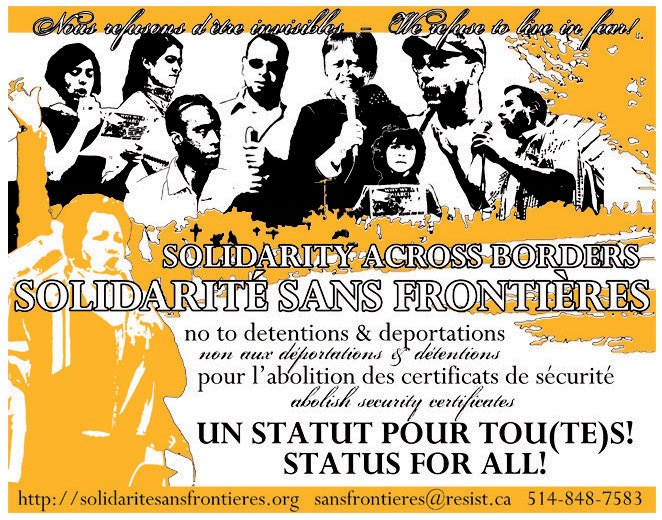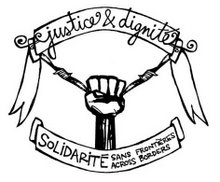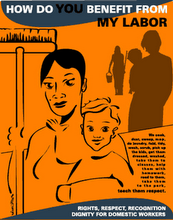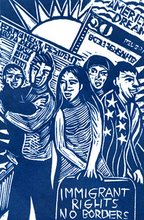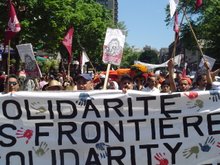 Andrew Duffy, The Ottawa Citizen- Published: Saturday, January 26, 2008 Photo: Nathan Denette, The Canadian Press
Andrew Duffy, The Ottawa Citizen- Published: Saturday, January 26, 2008 Photo: Nathan Denette, The Canadian Press






 How Benamar Benatta 'disappeared' after 9/11. The Canadian government sent him to the U.S. where he was accused of being behind the 9/11 bombings: 'The way they accused me, I thought my life was over'
How Benamar Benatta 'disappeared' after 9/11. The Canadian government sent him to the U.S. where he was accused of being behind the 9/11 bombings: 'The way they accused me, I thought my life was over'
Toronto's Benamar Benatta calls himself a forgotten victim of Sept. 11.
Mr. Benatta, 33, a former Algerian air force lieutenant, also has the dubious distinction of being the first victim of Canada's sometimes overzealous security response to the U.S. terror attacks.
Former Ottawa engineer Maher Arar is the best known victim of Canada's post-9/11 national security excesses. A secretive federal inquiry is now exploring what happened to three other Arab Canadians -- Abdullah Almalki, Ahmad El-Maati and Muayyed Nureddin -- who, like Mr. Arar, say they were tortured in Syria based on faulty Canadian intelligence.
Mr. Benatta's plight predates the others, but remains little known. He has also been unsuccessful at winning an official review of his case.
So he has launched a $35-million lawsuit against the federal government for what he says was his illegal removal to the U.S. as a terror suspect one day after the World Trade Centre was levelled.
Initially, he was considered a potential conspirator in the attacks. And, although he was cleared of any connection to terrorism by November 2001, he would spend almost five years in U.S. custody, where he would suffer serious degradation and mistreatment, before being mysteriously returned to this country at the behest of Canadian officials.
"You just can't take somebody who's innocent and accuse him of being involved in the worst terrorist crime -- and then just close your hands and make like nothing happened," says Mr. Benatta, who now holds refugee status in Canada.
"I would like to have answers about why. Somebody out there owes me an apology. Canada just can't take an innocent person and send him away and forget about him for five years."
Mr. Benatta will visit Ottawa on Tuesday to relate his nightmarish saga to an audience at the Public Service Alliance of Canada Hall. The next day, he will march with supporters to the Prime Minister's Office to renew his demand for a public review of his case.
His story begins in Algeria where he was born on May 16, 1974, the youngest of 10 children. Mr. Benatta joined the military at 18, and after a year of basic training, was sent to university where he studied aeronautical engineering. After graduation, he returned to the military and taught aeronautics.
But Mr. Benatta says he became uncomfortable with the military crackdown in Algeria that followed the annulled 1992 general election won by an Islamist party.
"I opposed the methods employed by the military," he says. "There were civilians caught in the line of fire."
In December 2000, he travelled to the U.S. for training with a major U.S. arms contractor, Northrup Grumman. But Mr. Benatta had secretly decided to defect: he carried with him his life's savings and his university diploma. In April 2001, he abandoned his training program and fled to New York City.
Mr. Benatta, however, figured his chances of making a successful refugee claim were better in Canada, so in early September 2001, he made for the border.
"I had the impression that Canada had protection for human rights," he says.
At the Fort Erie border crossing, Mr. Benatta presented the false green card and social security card he had obtained in New York City. When an immigration official questioned him, he admitted they were fraudulent and claimed political asylum.
He was held in custody at the Niagara Detention Centre while Canadian immigration officials confirmed his identity. Mr. Benatta was in custody on Sept. 11 and remained unaware that the world had changed drastically that morning.
The next day, he was interviewed by two officials who did not identify themselves. According to Mr. Benatta, he was asked whether he could fly a plane -- he can't -- and about his military training.
Hours later, he was placed in the back seat of a car. Mr. Benatta thought he was going to a bigger detention facility in Toronto, but instead, he was driven across the Rainbow Bridge and handed over to U.S. officials.
Mr. Benatta insists he did not withdraw his refugee claim -- as Canadian officials would later contend -- and never acceded to his transfer to the U.S.
Indeed, he says he didn't realize he had crossed the border until he saw the uniforms on the men who took him into custody.
"No one told me we were going to the States whatsoever," he says. "They just put me in the back of the car."
Mr. Benatta first learned of the terror attacks on the evening of Sept. 12 during an interview with FBI investigators. He quickly realized he was being accused of participating in the deadliest attack on U.S. soil since Pearl Harbor.
"They said, 'If you co-operate now, we are going to give you a life sentence instead of death penalty,'" he says. "They did receive certain information that I am the one who trained the 19 people (hijackers) or orchestrated the Sept. 11 attacks. That's the information they give to me."
Four days later, Mr. Benatta was transferred to the Metropolitan Detention Centre (MDC) in Brooklyn, New York, where he was held along with 83 other "high interest" suspects in the FBI's investigation of the Sept. 11 terror attacks. Most of the men had been detained on the strength of various immigration offences.
Mr. Benatta was held incommunicado and denied access to a lawyer; his family in Algeria thought he had disappeared.
Mr. Benatta says he repeatedly had his head slammed against the wall by MDC guards, who also shackled his legs painfully tight. He was left outside in the cold and punished for speaking to other prisoners by being denied food. The lights in his cell were kept on for 24 hours a day.
(Mr. Benatta's description of his abuse is consistent with the findings of a report by the U.S. Justice Department's Office of the Inspector General, which issued a damning assessment of the Brooklyn detention centre in December 2003. The U.S. Justice Department uncovered a videotape that, among other things, recorded repeated and degrading strip searches. The report recommended disciplinary action against 10 individuals for their "abusive" behaviour.)
Mr. Benatta was repeatedly interrogated by FBI agents assigned to the Terrorism Task Force.
"The way they accused me, I thought it was over," he says. "I thought they didn't find nobody who did it and they were just going to accuse me. They would present me to the people that I was the one who did it. I thought that was it: I thought my life was over."
But on Nov. 15, 2001, according to evidence later made public in U.S. District Court, the FBI officially cleared Mr. Benatta of any connection to terrorism.
Yet Mr. Benatta continued to be held in detention. He was subsequently charged with being in possession of false identification: his phony green card and social security number.
He remained incommunicado at the Brooklyn detention centre until April 30, 2002, when he was transferred to a jail in Buffalo, New York, and finally allowed access to a lawyer.
Two years after first being detained, Mr. Benatta's criminal case went before U.S. District Court Judge Kenneth Schroeder, who castigated federal prosecutors for their legal "shams" and "ridiculous" delays. The judge said Mr. Benatta had been denied his right to a fair and speedy trial.
Based on a recommendation from Judge Schroeder, the criminal charges against Mr. Benatta were dropped in October 2003.
But Mr. Benatta's ordeal was not over. Since he still did not have legal standing in the U.S., he applied for political asylum; he was kept in immigration detention because U.S. officials considered him a "flight risk."
After his bid for asylum was denied on April 7, 2004, he launched an appeal. He was told he could be released if he posted a $25,000 bond, but Mr. Benatta knew no one with that kind of money in the U.S.
His appeal was denied in September 2004, which meant that Mr. Benatta faced the terrifying prospect of being returned to Algeria. He believed that as a military defector, he would be imprisoned and tortured if sent back.
He appealed his deportation and won a stay of that order in January 2005, but he was not released from custody.
It was about this time that Janet Dench, director of the Canadian Council for Refugees, heard about his ordeal and began to work for Mr. Benatta's return to Canada. The Benatta case had been brought to the attention of the United Nations by the American Civil Liberties Union; his plight had also been written about by the Washington Post.
Ms. Dench began to lobby the Canadian government to recognize its critical role in the case and to make things right for Mr. Benatta.
Canada, she told federal officials, had no legal basis for removing Mr. Benatta and had a moral duty to rescue him from U.S. custody.
"It's extremely, extremely disturbing when you find officials violating the law," she says. "It's one of the most basic things you expect: that the basic requirements of the law will be followed by our officials.
"And in many ways, it's worse when it happens in the heat of the moment, on the 12th of September, because that's exactly when you need laws to be scrupulously respected."
After what she describes as a "long, slow process," Ms. Dench's representations gained traction in Ottawa.
On July 11, 2006, the Canadian government sent the U.S. Department of Homeland Security a curious letter.
Written by a Canadian consulate official in Buffalo, the letter announced that Canada would offer Mr. Benatta a temporary resident permit to allow him re-entry into this country.
In his letter, obtained by the Citizen, Consul Randy Orr confirmed that Mr. Benatta had been detained in Canada on Sept. 5, 2001. His immigration file indicates that Mr. Benatta expressed a desire to seek refugee status in Canada, Mr. Orr said, noting there is no record of such a claim.
"On September 12," Mr. Orr wrote, "Mr. Benatta was returned to the United States. Information on the file indicates this was a voluntary withdrawal. However, there is no documentation to support this, such as a copy of the 'Allowed to Leave' form, as would normally be the case."
Ms. Dench says Canadian officials should be given full credit for coming to Mr. Benatta's aid. "It certainly wasn't a full restitution," she says, "but at least they had the guts to take some action to get him out of detention."
Dressed in a prison jumpsuit and shackled, Mr. Benatta was driven back across the border to Canada on July 20, 2006.
Chris Williams, a spokesman for the Canada Border Services Agency (CBSA), said he could not comment on the Benatta case because it's before the courts. He refused to say if the federal government continues to believe that Mr. Benatta willingly went to the U.S. "We're currently reviewing the allegations and examining the claim," Mr. Williams said.
Mr. Benatta's lawyer, Nicole Chrolavicius, says the Canadian government bears some responsibility for what happened to him.
"They were the instigators of the whole event," she says. "They identified him as a suspect in the Sept. 11 terrorist attacks and then handed him over without any legal process whatsoever."
Mr. Benatta's case must be fully explored, Ms. Chrolavicius contends, because it stands as the first example of how the Canadian government moved "outside the law" after the terror attacks in New York and Washington.
"He was lifted completely out of the immigration realm, completely out of any thought of extradition, for example, lifted outside of any legal process and stuck in the back of a car and driven over the border," she says. "He was not deported, or removed, or refouled. He was transferred outside the scope of any lawful authority ...This was an illegal rendition."
Mr. Benatta's lawsuit alleges that Canadian officials later attempted to cover-up their misconduct by falsely suggesting that Mr. Benatta withdrew his refugee claim in Canada. The allegations in the lawsuit must be proven in court.
The federal government has yet to file a statement of defence in the case and is attempting to have the matter moved to Federal Court.
For his part, Mr. Benatta wants answers to some fundamental questions. Why was he sent to the U.S. without due process? What did Canadian security officials tell their U.S. counterparts about him? Why did Canadian officials act so rashly when he was already in custody? Why didn't Canadian security agencies do their own assessment of his alleged connections to 9/11? Why did the Canadian government not seek his return until 2006?
"Why throw me in the car like a package and deliver me like I'm nobody?" he asks.
Mr. Benatta now lives on social assistance in Toronto. He has been unable to get work, he says, because his name has been tied to terrorism. He also finds it hard to explain the five-year gap in his resume. He holds out little hope of resuming his career as an aeronautics engineer.
In November, Mr. Benatta finally won his claim for refugee status in Canada -- a milestone he regards as bittersweet.
"After seven years of fighting, that was a relief. I am very grateful to Canada to be provided protection here," he says. "But I can't get on with my life. Not yet."http://www.canada.com/ottawacitizen/news/observer/story.html?id=6cfbd053-d721-4146-9cb9-3e02e1558093&p=1
